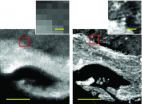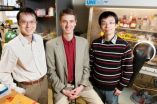(Press-News.org) PROVIDENCE, R.I. [Brown University] — Romping clumps of misfolded proteins are prime suspects in many neurological disorders including Alzheimer's, Parkinson's, and Creutzfeld-Jakob Disease. Those diseases are devastating and incurable, but a team of biologists at Brown University reports that cells can fix the problems themselves with only a little bit of help. The insight suggests that there are more opportunities to develop a therapy for protein misfolding than scientists had thought.
"There are multiple steps that you could target," said Susanne DiSalvo, a Brown biology graduate student and lead author of a paper published in advance online March 20 in Nature Structural and Molecular Biology.
In the study, the research team, led by Tricia Serio, associate professor of medical science, explains how two different beneficial mutant prions managed to foil the amplification of harmful clumps of misfolded proteins in yeast. Cells have an internal quality assurance system to break up and refold misfolded proteins, but that system can be overwhelmed by diseases. DiSalvo was the first to observe that the mutants act at distinct stages to tip the balance back in favor of the cells, allowing them to overcome the problem.
Serio says the molecular mechanisms appear to explain how similar mutants solve protein misfolding in mammals, including people. The phenomenon had been poorly understood and has never been exploited to develop a successful therapy.
Misfolding is a vulnerable process
Until now most scientists guessed that the only way to stop the runaway misfolding was right at the beginning and assumed the mutants must be blocking that first step to keep the protein in a harmless form. DiSalvo's work instead suggests that there are many opportunities throughout the process where even a mild intervention could give cells what they need to gain the upper hand, Serio said.
"That's one of the biggest outcomes of Susanne's work: that if you just even slightly interfere with this process, the cell can deal with it and get rid of it," Serio said. "The dogma in the field is that these conformations were so abnormal the cell couldn't resolve them. But what we've found is that this process of misfolding is so efficient the cells can't keep up with it. If you make it even just a little bit less efficient the cell can get rid of the pathological state."
One mutant prion, Q24R, hinders the ability of misfolded proteins to aggregate into harmful clumps. It's like a dryer sheet that cuts down on static cling and makes it easier to fold laundry. Another helpful mutant prion known as G58D, assists the cell by speeding up its ability to unfold and refold misfolded proteins. That's more like a friend who helps untangle strings of holiday lights when they come out of storage.
DiSalvo's experiments showed how the mutants and cells work together. Cells would only be cured when she both added a mutant and allowed the cells' own quality assurance system to work. Adding the mutant G58D, for example, could cure a cell of infection by the Sup35 prion, but if she perturbed the cell's quality assurance system then G58D would not work.
The results show the importance of delving deeply into molecular networks, said Stefan Maas, who oversees Serio's and other cellular signaling grants at the National Institutes of Health.
"These results are a great example of the power of system-level studies," Maas said. "By showing how two beneficial mutants cure the cell of prions, this study has revealed that small changes applied to distinct components of a molecular network can dramatically alter the outcome for the cell. These new insights may lead to new strategies for preventing or treating disorders that involve protein deposits."
But those strategies may require turning proteins into pills. Serio noted that while beneficial mutant prions confer resistance to prion infection in nature, they haven't been successful in reversing an established infection because sustained delivery into the body is too challenging. However, a small molecule drug mimic, if developed, could target infected tissues more effectively over a longer period to slow or perhaps even reverse disease progression.
In the paper the researchers conclude, "A system-based approach to prion intervention represents a potentially promising direction in which to explore future therapies."
INFORMATION:
Other authors on the paper include Brown researchers Aaron Derdowski and John Pezza.
END
With intensity a million times brighter than sunlight, a new synchrotron-based imaging technique offers high-resolution pictures of the molecular composition of tissues with unprecedented speed and quality. Carol Hirschmugl, a physicist at the University of Wisconsin-Milwaukee (UWM), led a team of researchers from UWM, the University of Illinois at Urbana-Champaign and University of Illinois at Chicago (UIC) to demonstrate these new capabilities.
Hirschmugl and UWM scientist Michael Nasse have built a facility called "Infrared Environmental Imaging (IRENI)," to perform ...
Chronic fatigue syndrome (CFS) is characterized by unexplained and debilitating tiredness and is associated with headaches, disrupted sleep, muscle pain and difficulty in concentrating. New research published by BioMed Central's open access journal BMC Medicine shows that ethnicity, depression, lack of exercise or social support, and social difficulties are major risk factors for CFS.
A multi-institute study funded by the Medical Research Council (UK), involving researchers across London and Manchester, looked at data from over 4000 adults living in England. The result ...
Direct experience of extreme weather events increases concern about climate change and willingness to engage in energy-saving behaviour, according to a new research paper published in the first edition of the journal Nature Climate Change this week.
In particular, members of the British public are more prepared to take personal action and reduce their energy use when they perceive their local area has a greater vulnerability to flooding, according to the research by Cardiff and Nottingham universities.
Although no single flooding event can be attributed to climate change, ...
A team of scientists from Princess Margaret Hospital have created an organic nanoparticle that is completely non-toxic, biodegradable and nimble in the way it uses light and heat to treat cancer and deliver drugs. (A nanoparticle is a minute molecule with novel properties).
The findings, published online today in Nature Materials (DOI: 10.1038/NMAT2986) are significant because unlike other nanoparticles, the new nanoparticle has a unique and versatile structure that could potentially change the way tumors are treated, says principal investigator Dr. Gang Zheng, Senior ...
CHAMPAIGN, Ill. — The batteries in Illinois professor Paul Braun's lab look like any others, but they pack a surprise inside.
Braun's group developed a three-dimensional nanostructure for battery cathodes that allows for dramatically faster charging and discharging without sacrificing energy storage capacity. The researchers' findings will be published in the March 20 advance online edition of the journal Nature Nanotechnology.
Aside from quick-charge consumer electronics, batteries that can store a lot of energy, release it fast and recharge quickly are desirable for ...
DURHAM, N.C. – You may remember the color of your loved one's eyes for years. But how?
Scientists believe that long-term potentiation (LTP) – the long-lasting increase of signals across a connection between brain cells -- underlies our ability to remember over time and to learn, but how that happens is a central question in neuroscience.
Researchers at Duke University Medical Center have found a cascade of signaling molecules that allows a usually very brief signal to last for tens of minutes, providing the brain framework for stronger connections (synapses) that can ...
Social Security disability benefits provide an important safety net for thousands of Americans: studies cited by the Social Security Administration show that a 20-year-old worker has a 3-in-10 chance of becoming disabled at some point before reaching retirement. The benefits furnished through Social Security help disabled workers and their families maintain normal, productive lives. But what about those workers whose disability claims are denied by the SSA? Fortunately, a process is set forth that allows disabled workers to seek review of claims that may have been wrongly ...
Contact: Camille Parmesan
parmesan@uts.cc.utexas.edu
512-232-1860
Michael C. Singer
sing@mail.utexas.edu
512-471-4506
University of Texas at Austin
Think globally, but act locally when studying plants, animals, global warming, researchers advise
AUSTIN, Texas—Global warming is clearly affecting plants and animals, but we should not try to tease apart the specific contribution of greenhouse gas driven climate change to extinctions or declines of species at local scales, biologists from The University of Texas at Austin advise.
Camille Parmesan, Michael ...
A woman died because of a fatal accident, and her family has sued a Lynwood village clerk for negligence after the crash, the Chicago Sun Times reported.
Rolle Valle, driving the wrong way on Illinois Route 394 near East Lincoln Highway, crashed head-on into two cars.
Valle, the clerk in the village of Lynwood, has been charged with reckless homicide and aggravated DUI in connection with the fatal accident.
State Police said Valle was driving northbound in the southbound lane. His vehicle struck the other car head-on and the impact caused the car to roll over in ...
Measuring the levels of small molecules in the blood may be able to identify individuals at elevated risk of developing type 2 diabetes as much as a decade before symptoms of the disorder appear. In a report receiving advance online release in Nature Medicine, a team led by Massachusetts General Hospital (MGH) researchers describes finding that levels of five amino acids not only indicated increased diabetes risk in a general population but also could differentiate, among individuals with traditional risk factors such as obesity, those most likely to actually develop diabetes. ...



